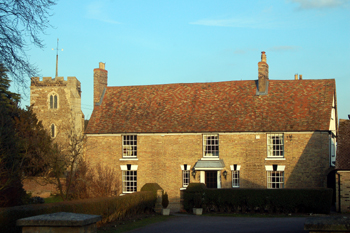Church Farmhouse - 41 High Street Roxton
![Church Farmhouse in 1960 [Z53/97/24]](/CommunityHistories/Roxton/RoxtonImages/Church Farmhouse in 1960 [Z53-97-24].jpg)
Church Farmhouse in 1960 [Z53/97/24]
Church Farmhouse was listed by the former Department of Environment in August 1983 as Grade II, of special interest. The department dated the property to about 1600, though it was refaced in the 19th century. The farmhouse is of timber framed construction, with colour washed plaster infill to the south, colour washed roughcast to the east, and 19th century gault brick facing to the north and west. The house has an old clay tile roof and is built in an L-plan, with lean-to additions to rear. It comprises two storeys and attics. A first floor bedroom retains a plasterwork decorative panel over a blocked fireplace, showing the royal arms of James I (1603-1625), flanked by caryatids and portrait heads.
During World War One the country was almost brought to its knees by unrestricted submarine warfare. By 1917 the situation was so bad that large amounts of ancient meadow and pasture land were ploughed up to sow arable crops to try to prevent the country starving. Indeed, the ill-fated Third Battle of Ypres, known as the Battle of Passechendaele, was launched partly with the intention of capturing ports on the Belgian coast used by German U-Boats.
Church Farm, Roxton, was one of those where pasture was ordered to be ploughed up by the War Agricultural Executive Committee of Bedfordshire County Council. The farmer, William Hull, objected [WW1/AC/OP1/1-2]. The reason why ancient pasture was left unploughed was that the soil conditions were likely to be unwelcoming to arable crops and the farmer thus sought to avoid breaking the land up. Fortunately, the Admiralty’s adoption on the convoy system defeated the U-Boats and saved the country from starvation.
The Rating and Valuation Act 1925 specified that every building and piece of land in the country was to be assessed to determine its rateable value. The valuer visiting Church Farm [DV1/H13/4] found it owned and occupied by William Hull. The valuer commented: “Mr. Hull out, saw Mrs. Hull, water from well”. A later hand has commented: “Buildings enough for 300 acres. Dutch Barn. Tennis Court”.
The farm comprised around fifty acres. The farmhouse contained a small hall, a dining room, a drawing room, a kitchen, a scullery, a pantry, four bedrooms, two attics and a washhouse with a tennis court outside. The valuer commented: “Good front poor at back”.
The homestead comprised: a garage; a stable for two horses; a stable for seven horses; a three bay open shed; a loose box; another stable for seven; a chaff house; a one bay shed; three loose boxes; a barn; a six bay cart shed; a six bay open hovel; two kennels used as hen houses; a seven bay open hovel; two more loose boxes; a Dutch Barn and an implement shed. The buildings were chiefly weather-boarded and slated. The valuer commented: “Buildings excessive and very little used”. Alterations were made to the property in 1937 [RDBP2/989]
Directories for Bedfordshire were published every few years from the mid 19th to the mid 20th centuries. From these it is possible to see when occupiers were at Church Farm. Naturally, the dates below are not beginning and end dates of their stays but simply the first and last dates they are noted in directories:
1898-1906: Joseph Banks;
1910-1936: William Hull;
1940: Bates Brothers
 Church Farm March 2010
Church Farm March 2010